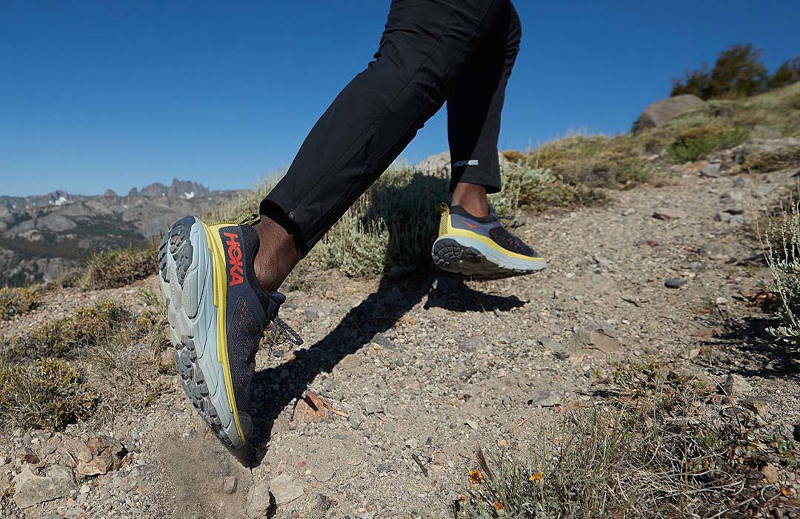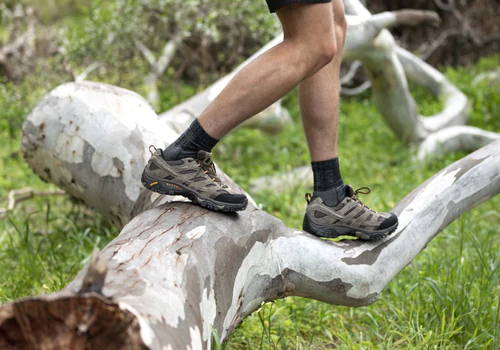Enjoy running in nature!
How to Choose a Trail Shoe
Trail running and walking requires a combination of balance, stability, comfort and safety. Appropriate footwear for the changing terrain and varied off-road conditions is essential. Before you pick your trail shoes, you need to ask yourself what will be right for you? Will you be going straight from the car to the muddy trail? Or would a combination or trail and road running be better suited to your routine? Below we break down what to consider and what to look for in your trail shoe plus seven essential tips for trail running.
What makes a shoe - a trail shoe?
The tread and the upper are the biggest differences between road and trail shoes. Trail shoes often have more pronounced lugs on the outsole of the shoe made of different rubbers to provide more traction on loose dirt, rocks and mud surfaces.
The upper is also quite different in a trail shoe. Most come with toe guards to protect your feet. The uppers and laces in general are stronger and less likely to tear than your normal road runners which aren’t built to withstand stressful trail runs. Different levels of grip and tread determine the function of the shoes – the more aggressive the grip, the better the shoe functions on muddy, unstable or wet terrain.

Soft ground trail-only shoes
However, some shoes function adequately in both roles. You can determine this yourself by examining the aggressiveness of the lugs/tread, or ask our well-trained staff in store. Less aggressive tread allows the shoe to function as a better all-rounder. The more aggressive grips will wear down faster on concrete, so it’s important to get the shoe that works best for your goal and terrain.


All rounders
It can also be worth considering a waterproof option, especially if you won’t have time to let your shoes dry properly between runs i.e. Trail running trips, multi day events. Some waterproof options are available.
Get it right, don't just get by
Additionally, it can be better to leave your foot slightly under corrected so you roll in instead of roll out as this can potentially risk an ankle sprain on very uneven ground. If this is something you are worried about, we recommend you come into store and have one of our specially trained staff assess you to ensure you are in the best shoes for your activity level and are as safe as can be when out in the wilderness. The last thing you want is a sprained ankle half way up a mountain!
Trail running is an enjoyable way to explore the outdoors and exercise. If you are racing, please remember there is mandatory equipment as per each event organiser. Preparation is key, trial your gear, stay safe and above all have fun and enjoy yourself.
7 Essentials for trail running
You may ask, what is considered trail running? Well the answer depends on who you ask. Really, any type of running that is off-road could be considered trail running. Obviously, there is your more extreme trail running like steep, technical mountain trail running but remember, trail can be anything that has a loose terrain underfoot for example dirt tracks. Trail running puts you right in the middle of nature.
Depending on the terrain it can be strategic to walk and not run at certain points, this allows us to enjoy our surrounds and take it all in. It improves the scenery of your run letting you explore without all the stoplights, busy streets and pounding pavement. Although it takes a little bit of gear, each piece is important. Here are 7 essentials to take with you. Keep in mind this is a basic list of trail essentials, your specific trail runs and the conditions may require more or less gear.
1. Correct Footwear – different terrain (traction and protection)
Trail running and walking requires a combination of balance, stability, comfort and safety. Appropriate footwear for the changing terrain and varied off-road conditions is essential. Trail shoes often have more pronounced lugs on the outsole of the shoe made of different rubbers to provide more traction on loose dirt, rocks and mud surfaces. More durable tear resistant uppers or even water proof.
2. Protective Clothing
Apart from the correct trail running footwear, one of the most essential components of trail running is the clothing you wear. Make sure to layer well and keep in mind comfort, breathability, support and protection. It’s important to make sure to be prepared in case the weather turns windy, cold or wet. Clothing ranging from longer socks to warmer layers are essential when heading out on certain trails as the weather can be unpredictable.
3. Hydration – water is a no-brainer
It’s important to know reliable water sources on your trail route. The solution is to keep water and hydration supplements available by bringing a soft flask or hydration pack on your run (depending on the distance of course). Yes, it does add some additional weight but the benefit of wearing a pack is the handy pockets where you can add other essentials like gels, bars, phones and other equipment.
4. Nutrition
Keeping up energy levels is crucial for long trail runs. Figuring out what foods work for your individual body will take some trial and error as some people can react to different foods when they run. That’s why gels can be a great alternative as they provide nutrition in a liquid form. The key is to bring gels, bars and smaller snacks as it won’t way you down with a bag full of food. If you’re preparing for a race, always remember to trial in training don’t try a new gel or bar on race day.
5. Illumination
Depending on how long you’re heading out/what time you’re going out, it’s a good idea to bring a headlamp. They are small, light and have long battery life as well as allowing a hands-free operation. Do not get caught out if you end up running behind schedule or you are running on a dark day where the sunlight is minimised by the trees above you.
6. GPS Units
This may seem like a no brainer but without any roads or familiar landmarks it can be hard to navigate the trails. As it is often an unfamiliar area, you’d be surprised how similar trails can look. GPS Units are great way to help you navigate, they also have the bonus of tracking your distance and speed.
7. Sun protection – hats, sun cream, sunglasses
Not every trail run will on bright sunny days or have sun drenched trails but when you do you want to be protected from the sun. Everyone has their preference of hats, visors etc. so make sure you are comfortable but remember to be sun safe.
Trail running is an enjoyable way to explore the outdoors and exercise. If you are racing, please remember there is mandatory equipment as per each event organiser. Preparation is key, trial your gear, stay safe and above all have fun and enjoy yourself. If you have any questions or want to talk to our staff about trail running, please come in store or send us an email and we will be happy to discuss all things trail.



